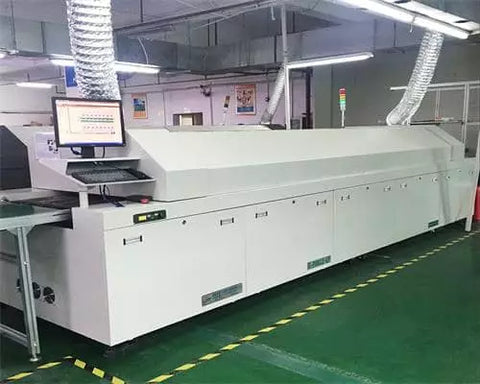
Reflow Soldering Process
Reflow soldering is a bit different from wave soldering. In this method, a sticky solder paste is applied over the board using a solder stencil. The solder paste contains solder and flux, so both are applied at the same time. Then the components are placed using a pick and place machine. As the paste is sticky, it glues the components on the board so that they do not fall during the process.
After that, the boards pass through a reflow soldering oven with the help of a conveyor. The temperature inside the oven is more than the melting point of the solder, so it melts the solder, and the components are perfectly soldered to the board. Finally, the board is cooled to harden the solder.
Before reflow soldering, two more steps make the board ready for the soldering process. First, the board is preheated to increase its temperature so that the soldering process can be done easily. Then, the board goes through a thermal soak in which the flux inside the solder paste is activated. These two processes are involved in reflow soldering to facilitate the process.

Temperature curve in Reflow soldering oven

Temperature curve in Reflow soldering oven
Advantages of reflow soldering
- The soldering quality of reflow soldering is good, and it is deeply trusted by consumers and PCBA manufacturers
- Reflow soldering is most suitable for SMT PCB assembly;
- Reflow soldering is most suitable for mass PCB assembly;
- Reflow soldering can assemble a variety of SMT package types
- The process flow of reflow soldering is easier to control and monitor
- Reflow soldering can limit the amount of solder and effectively avoid defects such as bridging;
- Reflow soldering can effectively reduce the damage of thermal shock to electronic components
